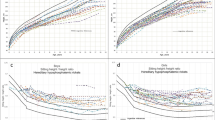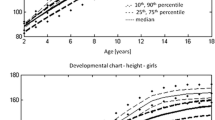Abstract
Growth in height of 16 patients (5 boys and 11 girls) with hypophosphataemic rickets (HR) was studied in a longitudinal survey. The data shortly before and during puberty were analysed on the basis of Preece Baines curves, fitted to the original data; for the analysis at the age of 5 years, the original data were used. It appeared that the overall shape of the individual and average growth pattern could be adequately described by the Preece Baines method. The results further showed that from the age of 5 years onwards, average height was approximately two standard deviations below the normal mean for Dutch children. The patients showed a normal pubertal growth spurt which was, in general, insufficient to restore the growth retardation already established before adolescence. The four children who did show catchup growth between the age of 5 years and adulthood had minimal rachitic lesions. The greater impact of the disease on growth in early childhood than on adolescent growth could be explained by the fact that HR mainly affects the growth of the legs, the major contributor to body size in early childhood. Finally, it was found that the difference between bone age, as determined by the Tanner Whitehouse (TW2)-method, and chronological age was not significant and the adult height in all patients except two could be adequatcly predicted from bone age and height.
Similar content being viewed by others
Abbreviations
- CA:
-
chronological age
- DHT:
-
dihydrotachysterol
- HR:
-
hypophosphataemic, vitamin D-resistant rickets
- PAH:
-
predicted adult height
- PB1:
-
Preece Baines model I
- SD:
-
standard deviation
- sds:
-
standard deviation score(s)
References
Balsan S, Tieder M (1990) Lincar growth in patients with hypophosphataemic vitamin D-resistant rickets: Influence of treatment regimen and parental height. J Pediatr 116:365–371
Büller HE, Tigchelaar-Gutter W, Steendijk R (1982) Improved bone structure in hypophosphataemic rickets after treatment with dihydrotachysterol and phosphate. In: Norman AW, Schaeffer K, Herrath D von, Grigoleit HG (eds) Vitamin D, chemical, biochemical and clinical endocrinology of calcium metabolism, de Gruyter, Berlin, pp 1041–1040
Evans GA, Arulanantham K, Gage JR (1980) Primary hypophosphataemic rickets: effect of oral phosphate and vitamin D on growth and surgical treatment. J Bone Joint Surg 62:1130–1138
Glorieux FH, Scriver CR, Reade TM, Goldman H, Rosenborough A (1972) Use of phosphate salts and vitamin D to prevent dwarfism and rickets in X-linked hypophosphataemia. N Engl J Med 287:481–487
Harrison HE, Harrison HC (1979) Disorders of calcium and phosphate metabolism in childhood and adolescence, WB Saunders. Philadelphia, pp 193–246
Harrison HE, Harrison HC, Lifshitz F, Johnson AD (1966) Growth disturbance in hereditary hypophosphatemia. Am J Dis Child 112:290–297
Hauspie RC (1989) Mathematical models for the study of individual growth patterns. Rev Epidemiol Sante Publique 37:461–476
Hauspie RC, Das SR, Preece MA, Tanner JM (1980) A longitudinal study of growth in height of boys and girls of West Bengal (India) aged six months to 20 years. Ann Hum Biol 7:429–441
Hauspie RC, Wachholder A, Baron G, Cantraine F, Susanne C, Graffar M (1980) A comparative study of the fit of four different functions to longitudinal data of growth in height of Belgian girls. Ann Hum Biol 7:347–358
Hauspie R, Das SR, Preece MA, Tanner JM, Susanne C (1985) Decomposition of sexual dimorphism in adult size of height, sitting height, shoulder width and hip width in a British and West Bengal sample. In: Ghesquière J, Martin RD, Newcombe F (eds) Human sexual dimorphism. Taylor and Francis London, pp 207–215
Herweijer TJ, Steendijk R (1985) The relation beween attained adult height and the metaphyseal lesions in hypophosphataemic vitamin D-resistant rickets. Acta Paediatr Scand 74:196–200
McEnery PT, Silverman FN, West CD (1972) Acceleration of growth with combined vitamin D-phosphate therapy of hypophosphataemic vitamin D-resistant rickets. J Pediatr 80:763–774
Preece MA, Baines MJ (1978) A new family of mathematical models describing the human growth curve. Ann Hum Biol 5:1–24
Rasmussen H, Pechet M, Anast C, Mazur A, Gertner J, Broadus AE (1981) Longterm treatment of familial hypophosphataemic rickets with oral phosphate and 1α-hydroxyvitamin D3. J Pediatr 99:16–25
Roede MJ, Wieringen JC van (1985) Growth diagrams 1980. Netherlands third nation-wide survey. Tijdschr Soc Gez Zorg 63:1–34
Schimert G, Fanconi A (1983) Early history of familial hypophosphataemic vitamin D-resistant rickets. Helv Paediatr Acta 38:383–398
Siegel S (1956) Nonparametric statistics for the behavioural sciences. McGraw-Hill, London
Steendijk R (1971) Metabolic bone disease in children. Clin Orthop 77:247–275
Steendijk R (1976) Aspects of growth and bone structure in hypophosphataemic rickets. In: Bickel H, Stern J (eds), Proceedings of the twelfth symposium of the Society for the study of inborn errors of metabolism. MTP Press, Lancester, pp 93–114
Steendijk R, Herweijer TJ (1984) Height, sitting height and leg length in patients with hypophosphataemic rickets. Acta Paediatr Scand 73:181–184
Steendijk R, Latham SC (1971) Hypophosphataemic vitamin D-resistant rickets: an observation on height and serum inorganic phosphate in untreated cases. Helv Paediatr Acta 26:179–184
Stickler GB (1969) Familial hypophosphatemic vitamin D-resistant rickets: the neonatal period and infancy. Acta Paediatr Scand 58:213–219
Tanner JM (1986) Use and abuse of growth standards. In: Falkner F, Tanner JM (eds) Human growth, Vol. 3, Plenum Press, New York, pp 95–109
Tanner JM (1990) Fetus into man: Physical growth from conception to maturity, revised and enlarged edition, Harvard University Press, Cambridge, Massachusetts, p 66
Tanner JM, Davies PW (1985) Clinical longitudinal standards for height and height velocity for North American children. J Pediatr 107:317–329
Tanner JM, Whitehouse RH, Marubini E, Resele LF (1976) The adolescent growth spurt of boys and girls of the Harpenden Growth Study. Ann Hum Biol 3:109–126
Tanner JM, Landt KW, Cameron N, Carter BS, Patel J (1983) Prediction of adult height from height and bone age in childhood. Arch Dis Child 58:767–776
Tanner JM, Whitehouse RH, Cameron N, Marshall WA, Healy MJR, Goldstein H (1983) Assessment of skeletal maturity and prediction of adult height (TW2 method), 2nd edn. Academic Press, London
Wieringen JC van, Wafelbakker F, Verbrugge HP, Haas JH de (1968) Growth diagrams 1965 (in Dutch). Wolters-Noordhoff, Groningen
Author information
Authors and Affiliations
Rights and permissions
About this article
Cite this article
Steendijk, R., Hauspie, R.C. The pattern of growth and growth retardation of patients with hypophosphataemic vitamin D-resistant rickets: A longitudinal study. Eur J Pediatr 151, 422–427 (1992). https://doi.org/10.1007/BF01959355
Received:
Accepted:
Issue Date:
DOI: https://doi.org/10.1007/BF01959355




